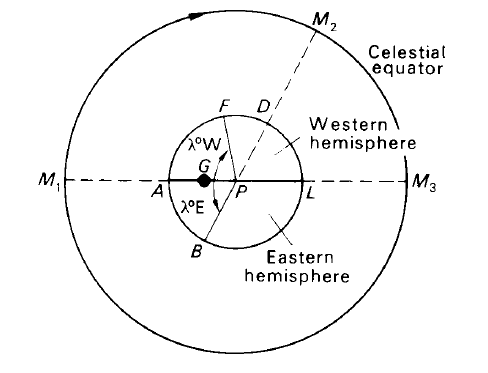


 الفيزياء الكلاسيكية
الفيزياء الكلاسيكية
 الكهربائية والمغناطيسية
الكهربائية والمغناطيسية
 علم البصريات
علم البصريات
 الفيزياء الحديثة
الفيزياء الحديثة
 النظرية النسبية
النظرية النسبية
 الفيزياء النووية
الفيزياء النووية
 فيزياء الحالة الصلبة
فيزياء الحالة الصلبة
 الليزر
الليزر
 علم الفلك
علم الفلك
 المجموعة الشمسية
المجموعة الشمسية
 الطاقة البديلة
الطاقة البديلة
 الفيزياء والعلوم الأخرى
الفيزياء والعلوم الأخرى
 مواضيع عامة في الفيزياء
مواضيع عامة في الفيزياء|
Read More
Date: 2-9-2020
Date: 22-7-2020
Date: 30-7-2020
|
The Greenwich date and zone time (with date)
In figure 1. the Earth is seen as viewed from above the North Pole P, the meridian of longitude PGA through Greenwich G meeting the equator in A. The International Date Line PL cuts the equator at L, its southern half being, of course, unseen.

Figure 1. The Greenwich date and zone time.
The standard meridian PB, of longitude λ◦ E, likewise meets the equator at B, where ∠APB =λ◦ E. Let a civil day, for example November 3rd, begin at the Date Line. It does so when the HAMS is 12h for that meridian, i.e. the mean sun is at M1, above the point A on the equator.
November 3rd will not begin for places in the zone keeping the zone time of the standard meridian PB until the mean sun has moved round the celestial sphere to be at M2, above D, where D is 180◦ distant from B round the equator.
For the Greenwich meridian and Zone 0, November 3rd will begin even later, when the mean sun has revolved until it is above L, at M3.
The Greenwich Date is then November 3rd, GMT 00h 00.
But the zone time with date at B is by then November 3rd, ZTλh, since ∠DPL = ∠APB = λ E.
The required relation is thus
GMT = ZT − λE
where λ is now expressed in hours.
By taking a western standard meridian at F, say, where ∠APF = λW, it is easily shown that the relation is given by
GMT = ZT + λW
λ being expressed in hours.
We may, therefore, combine these rules by adopting as before the convention that a western longitude is positive and an eastern one is negative. Thus,
GMT = ZT + λ.
Whereas ordinary clocks and watches keep the zone time of the particular zone in which their owners live, if continuous radio signals with time codes are not available, special chronometers are used by navigators to give GMT (or UT). These GMT chronometers are very accurate and knowledge of their error (fast on GMT or slow on GMT) and the rate is obtained by periodically checking their reading against the time signals broadcast throughout the world.
It was the development of such reliable timekeepers by John Harrison in the 18th century that solved the outstanding problem in navigation. The latitude of a ship at sea can be found by making the necessary astronomical observations but to determine the longitude involves a knowledge of the GMT. Until Harrison’s marine chronometers were built, no clock taken to sea remained accurate enough.
Applying the correction to a chronometer reading, therefore, gives the GMT. It should be noted, however, that a reading on a chronometer with a 12-hour dial contains an ambiguity not present with a 24-hour clock face



|
|
|
|
دور في الحماية من السرطان.. يجب تناول لبن الزبادي يوميا
|
|
|
|
|
|
|
العلماء الروس يطورون مسيرة لمراقبة حرائق الغابات
|
|
|
|
|
|
|
ضمن أسبوع الإرشاد النفسي.. جامعة العميد تُقيم أنشطةً ثقافية وتطويرية لطلبتها
|
|
|